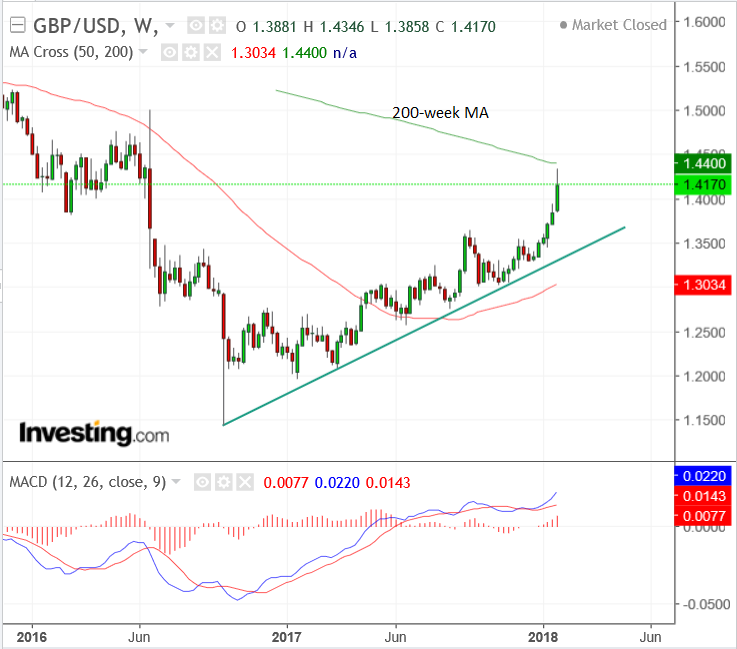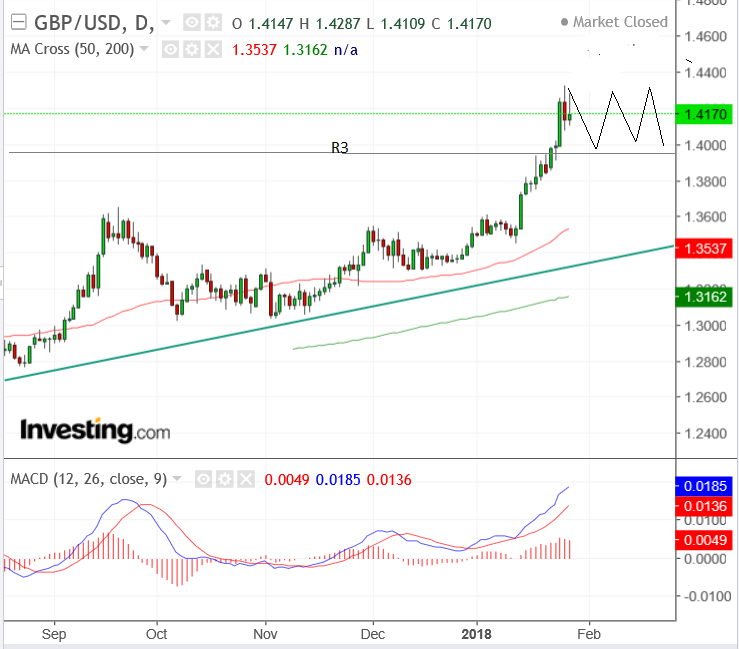The Pound-to-Dollar Rate Forecast for the Week Ahead

After a period of stupendous gains, the GBP/USD exchange rate may have finally reached a ceiling it will struggle to break.
The Pound is currently trading at 1.4160 against the US Dollar and is well above where even the most bullish forecasters would have estimated it at this point in 2018.
In December, bullish advisors noted 1.4000 as a probable target for the end of 2018 - not the beginning!
The exchange rate is, therefore, by some observations somewhat overbought. In addition to Sterling being potentially overbought, our technical studies show the exchange rate has just reached a significant chart level in the form of the 200-week moving average (MA) at 1.4400 (see below).

The moving average is likely to present a formidable obstacle to further upside and will probably lead to the exchange rate stalling, possibly pulling back or even reversing trend altogether.
Major moving averages such as the 50 and 200 MA are dynamic levels of support and resistance were a higher than average number of investors tend to make trading decisions - opening and closing orders in their vicinity.
This creates gluts of supply or demand which often cause prices to slow, stall or even reverse. In this case we imagine the supply of Sterling to be larger than normal, hence the prospect of the exchange rate's advance extending is challenging.
If GBP/USD does pull-back from the current highs it will probably correct back down to the level of the R3 monthly pivot at 1.3940.
Pivots are zones of support and resistance where short-term technical traders often enter the market and trade in the opposite direction to the incoming move.
Because of the 200-week MA capping upside and the overbought nature of the market we expect the pair to probably start going sideways for a while in between 1.3950 and 1.4400.

However, were Sterling to break this resistance then we would see a great deal of clear air above here and the exchange rate could well break into a new and longer-term uptrend. The battle over the 200 day moving average therefore promises to be a fascinating one.
Advertisement
Get up to 5% more foreign exchange by using a specialist provider to get closer to the real market rate and avoid the gaping spreads charged by your bank when providing currency. Learn more here.
Data and Events for the Dollar
It is an extremely busy week for the Dollar with no less than two exceptionally market-moving data releases: the Federal Reserve's open market committee meeting (FOMC) on Wednesday evening at 19.00 GMT and then Non-Farm Payrolls (NFP) on Friday at 13.30.
The FOMC is important because it votes to decide the level of base interest rates in the US which has a direct impact on the Dollar via inflows because higher rates attract greater inflows drawn by higher returns, which increases demand for the Dollar.
NFP's are important as a barometer of the health of the US economy and a gauge of inflation pressures. A higher NFP result tends to lead to expectations of higher inflation, which leads to expectations that the Fed will raise interest rates, which drives up the Dollar.
Probably of more import now than the headline NFP result is the data on wages since it is really wage inflation which tends to push up general inflation by giving workers more disposable cash to spend.
Indeed, the Fed's preferred gauge for inflation: Personal Consumption Expenditure (PCE), is out on Monday, January 29 at 13.30 and is forecast to show a 0.2% rise in December compared to November and a 1.5% rise compared to the same time a year ago.
Given the importance of inflation expectations in deciding interest rates, PCE could impact on the FOMC meeting if it surprises in either direction.
Data and Events to Watch for the Pound
The main data release in the week ahead for the Pound is survey data for Manufacturing and Construction in January, in the form of Markit IHS's purchasing manager indices (PMIs).
These are normally a reliable forward indicator of activity and trends within the broader economy and economists use them to predict growth. Markets will be looking for confirmation that the better-than-forecast economic momentum enjoyed by the UK economy in the final quarter of 2017, confirmed in last week's GDP data, has extended into the new year.
Manufacturing PMI is out at 9.30 GMT on Thursday, February 1 and is expected to rise to 56.5 from 56.3 previously.
Global investment bank TD Securities say economists are being too optimistic about Manufacturing and the index will fall to 55.9 instead of rising to 56.5; an outcome that would certainly weigh on the Pound we believe.
"We’re looking for a modest pullback in the manufacturing PMI after last month’s larger nearly 2pt decline, with the index falling from 56.3 to 55.9 in January. We expect to see some of the weakness in the flash Eurozone print reflected in the UK outcome," say TD Securities in a briefing to clients ahead of the new week.
Construction PMI is out at the same time on the following day and is forecast to fall to 52.0 from 52.2 in December. Note that the sector is in recession, according to official GDP data, so some recovery will be keenly anticipated. However, construction is a small component of the UK economy and the impact on Sterling will likely be small if any. Nevertheless, clues on longer-term prospects for the economy will be key for overall sentiment.
One further event of interest to Pound-watchers in the week ahead is Bank of England (BOE) governor Mark Carney's testimony to the Lord's Economic Affairs Committee at which he will have the opportunity to comment on the state of the economy and monetary policy before the 'black-out' period prior to the next official BoE rate meeting.
Markets are keen to ascertain whether or not the Bank of England will raise interest rates in 2018, in a follow up to 2017's rate rise. Markets are anticipating this is the case, but a bullish assessment by Carney could certainly be the catalyst to a higher Sterling in the coming week we believe.
Carney's appearance in Davos last week was striking in that he hinted that he is taking a more optimistic stance on the UK economy, seeing growth picking up sharply towards the end of the year as the UK "consciously recouples" with the accelerating global economy.
He will certainly be queried on this, and the answers will be closely followed by currency traders.
Get up to 5% more foreign exchange by using a specialist provider to get closer to the real market rate and avoid the gaping spreads charged by your bank when providing currency. Learn more here.










